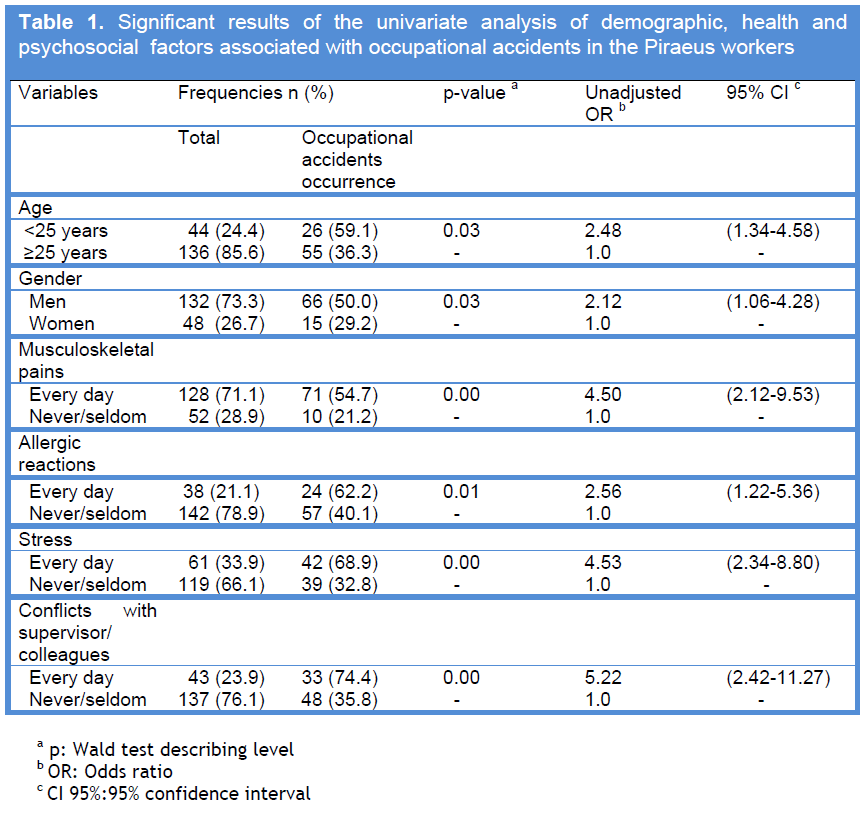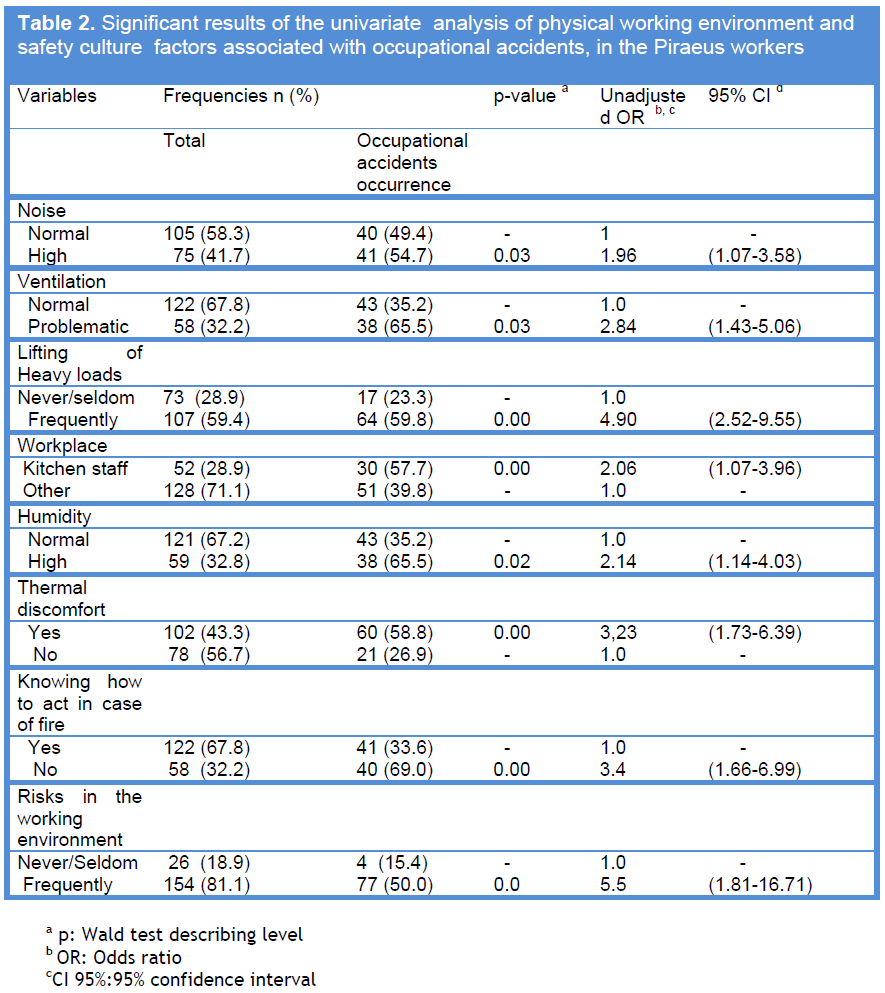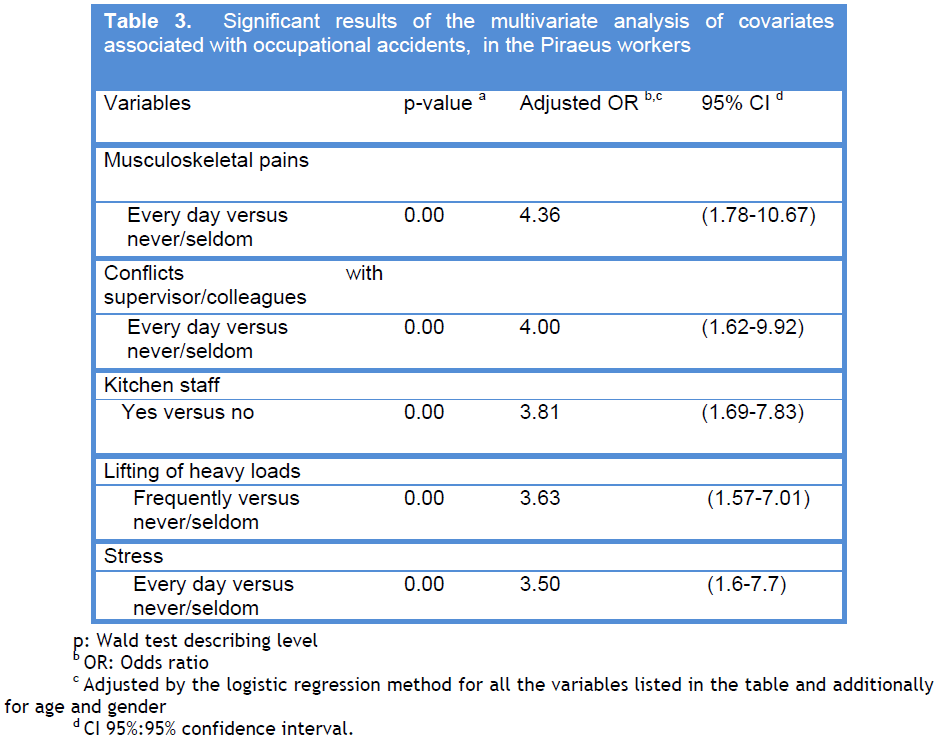Key words
Accidents, occupational, restaurants, prevalence, risk factors
Introduction
Occupational accidents contribute to absenteeism, light duty assignments or other work restrictions, high turnover, and higher workers’ compensation costs [1,2]. Also, it is known that, the incidence of occupational accidents varies highly from occupation to occupation and from industry sector to industry sector [1,3].
The restaurant sector is one of the most rapidly developing sectors in Europe and in the United States but it comprises equally one of the largest groups of workers injured on the job [4,5]. The works taking place in restaurants vary (kitchen staff, waiters, cashiers, cleaning personnel etc), as well as vary the hazards to which are exposed the labor force since they are performing different types of work [6,7].
Hazards and risks such as falls and slip ups, burns, violence, wounds by equipment, electrical devices, knives and blades, are very frequent in the work environment of the restaurant [8].
The traditional view of occupational accidents so states that accidents are produced by technological as well as individual human failures [9]. Nevertheless, during the three last decades researchers have increasingly recognized that industrial accidents are caused by a dynamic interaction between factors in the social and physical environments, that is, characteristics of the individual and the organization as well as technical forces [10]. In other words, researchers have increasingly recognized that occupational accidents are due to different demographic and lifestyle factors, working environment and health factors [11-14]. That is workers, must not only be protected from chemical and physical hazards but also from psychosocial hazards in the work environment [6].
Demographic and lifestyle factors include age, and gender, alcohol consumption and smoking [14]. Work environment and safety culture and climate fields comprise physical and psychosocial work environment factors. These categories include factors such as noise, temperature and machinery, workplace and ergonomic conditions, work support and work pressure, risk perception and competence [10,15]. All these factors describe the situational circumstances under which the accident took place. Health factors include perceived general health symptoms and symptoms of ill health such as musculoskeletal pains, allergic reactions and impaired hearing [10].
Recent study in Greece estimating the conditions of hygiene and safety in the personnel of restaurant and catering businesses in Santorini Island, has documented an uneasy high percentage of occupational accidents in relation to other studies (30.3%) [16]. Also, this study revealed that a significant (56.7%) percentage of workers don’t know about the dangers that they face in their work and this means lack of education programs in occupational safety and health. Nevertheless, few are the studies in Greece investigating the relation among these factors and the risk to being injured in the restaurant sector.
The aim of this study is: 1) to estimate the prevalence of occupational injuries in restaurants of the Piraeus Municipality of Attica, Greece, and 2) to investigate the role of the above mentioned factors, to the risk of being injured.
The expected contribution of this study is the improvement of the information in this field and consequently the optimization of choice in prevention policies.
Material and Methods
Study design and sample requirements
Piraeus is a city in the Attica Region and the most important port in Greece and the Eastern Mediterranean. It is the third largest municipality in Greece with a population of 175,697. Its area is 50.4 km2. The wider region of Piraeus comprises the municipality under the same name and six additional municipalities-outskirts, with a total population of 466,065 inhabitants and is the southwestern section of the city complex of Athens making it the outer rim of the capital.
Probabilistic sampling was carried out in 200 restaurants of the Piraeus municipality. We required a sample size of 180 workers to fulfill our objectives at a 95% confidence level. This sample size was calculated assuming a 30.3% prevalence of accidents according to a previous study in this area, 5% bound-on error and 10% non-response rate [16]. Our research comprised 30 out of the 200 restaurants in the Piraeus Municipality, that is, a percentage of 15% of the total population.
The sample consisted of 180 individuals, 48 women and 132 men, aged between 18 and 60 years, currently working in Piraeus restaurants.
For collecting data, a questionnaire for demographic, health work environment and safety climate data was used. This questionnaire is based on an anonymous estimate questionnaire of professional hazard by the Hellenic Institute of Occupational Health and Safety, of the Laboratory of Hygiene and Epidemiology of the Technological Educational Institute of Athens. There were data also used by the Nordic Questionnaire and the check list of the Olympic Games.
Written consent was required and drafted by the enterprises for their participation to the research, whereas there was the voluntary participation of the working force. The questionnaire was filled out in the presence of the researcher and the minimal time required was 50 minutes. Collection of data was made in the morning and afternoon hours during the period from Jan. 7, 2009 to March 7, 2009.
Pre-testing was carried out on 30 subjects to screen for potential problems in the questionnaire. No significant changes were made in the questionnaire. The interviewers discussed the questionnaire thoroughly before data collection, to decrease interviewer bias and variability. In the study, losses were 2%.
Data analysis
The data were entered and analyzed in Statistical Package for Social Sciences 15.0 (SPSS, Inc., Chicago, IL, USA). Data analysis was based on univariate and multivariate logistic regression.
The variables which had a p-value < 0.25 on univariate analysis were subjected to a stepwise multiple logistic regression analysis to determine which factors were independent predictors of occupational accidents in the subjects. The Hosmer and Lemeshow goodness-of-fit test was also used to select the final model [17]. Unadjusted as well as adjusted odds ratios for all potential covariates were recorded with a 95% confidence interval for each. A p-value of < 0.05 was taken as the criterion of significance for all purposes.
Results
71.1% of the participants were of Greek ethnicity. Among the participants, the mean age was 34.62 years (SD = 7.36) and 20.6% had not completed the remaining mandatory years of school graduation. 50% of the sample were never married. The majority of the workers were waiters (36%) and kitchen staff (29.8%) with 37.2% of them having working experience greater than 10 years and 15.6% having working experience less than 1 year in the workplace. Also, 77% of workers had been informed of hazards and their prevention in their working place.
Occupational accidents occurred to 44.3% of the workers in their present job and 41.3% of them had been seriously wounded. The majority of occupational accidents (56. 1%) were falls and slips.
Significant results (p < 0.05) of the univariate analysis of demographic, health and psycho-social factors as well as physical working environment and safety culture and climate factors associated with occupational accidents, are presented respectively on Tables 1 and 2.


As can be seen on Table 1, being male, aged below 25 years presenting permanent body pains, allergic reactions and stress and having frequently conflicts with supervisors/colleagues were significant risk factors for injuries associated to their current job. Also, it is worth noting, the above mentioned health factors are unbrokenly related to working conditions. The other characteristics investigated (education level, toxic habits, nationality, marital status) did not present significant associations with the risk of being injured and the results are not shown.
Also, the univariate analysis, (Table 2), revealed a strong relation between physical environment factors such as ventilation problems, thermal discomfort and humidity, noise, lifting of heavy goods, being kitchen staff. Significant associations also have been observed in some safety culture and climate factors such as the knowledge of how to act in case of fire and the belief in the existence of work hazards and the risk of being injured. Other factors such as inappropriate lighting, passive smoking, safety equipment, and working time did not present significant associations with the risk of being injured and the results are not shown.
Table 3 shows the final results of the multivariate analysis of the factors associated with the risk of being injured. After adjustments for confounders, working as kitchen staff, complaining of daily musculoskeletal pains (likely physical consequences of working conditions) and stress, having conflicts with supervisors and colleagues as well as having to lift heavy loads remained significantly (p < 0.05) associated with the risk of being injured.

Discussion
This study documents an uneasy situation: 44.3% of the workers under study had experienced a work injury in their current job. This percentage is significantly higher than in other studies of the same field [16].
Also, physical and demographic known risk factors such as workplace microclimate (thermal and ventilation discomfort and humidity problems), being male and young present significant association with the risk of being injured in univariate analyses but not in the final multivariate analysis[15,18].
Equally, safety culture and climate factors, such as knowledge of acting in case of fire and risks perception are significant in the univariate models. It is known that, perceived work safety and climate together with physical and psychosocial work environment factors significantly influence the workers’ experience of occupational accidents [1,10,19,20].
Nevertheless, no significant associations have been observed between these factors and the risk of being injured in the final multivariate model. Also, no significant associations have been observed between the presence of safety equipment (gloves, shoes, caps) and the workers experience of occupational accidents. It has been stressed that in the recent bibliography, the presence of safety equipment did not prevent occurrence of work injuries. It is likely that jobs with safety equipment were more hazardous ones, and either younger workers did not use them or used them incorrectly [15].
On the contrary, this study provides evidence that working as kitchen staff, complaining of daily musculoskeletal pains (likely physical consequences of working conditions) and stress, having conflicts with supervisors and colleagues, having to lift heavy loads are independent risk factors for being injured in an occupational accident. These results are consistent with a large body of literature. It is known that mental and physical stresses in the work are risk factors for being injured in an occupational accident [1,19,20]. Because of the nature of their work, kitchen staff tend to get more occupational accidents [4-6]. Health problems related to working conditions constitute also risk factors recognized by the international bibliography [10].
Some limitations of this study merit discussion. First, it is a cross sectional retrospective study and the study design allowed that data on independent variables were collected after an occupational accident occurred. It is possible that the scores on the risk factors have been influenced by the fact that a study subject had been injured in an occupational accident. Secondly, data on being injured in an occupational accident in this study were based on self report. They could not be verified by an independent observer and this might be a source of information bias. Additionally, data do not allow for an investigation for accident frequency per respondent.
However, as mentioned above the incidence data and the associations with work environment, health and demographic factors are all in line with the literature.
Conclusion
To conclude, in this cross sectional study, we found significant relative risks for being injured in an occupational accident for both psychosocial, health and physical working environment factors. The fact of the disquieting high οf workers, who experienced occupational accidents in their current work, makes it imperative that programs be created concerning Health Education for restaurant workers.
A useful measure would be the draft of guidelines addressed to enterprises as to the way they should handle health and safety at work issues. The results also suggest that the work group should be taken into account when studying accident frequency and health, safety and work environment interventions should be targeted towards the work group level in addition to the organization as a whole.
3380
References
- Swaen G, van Amelsvoort L, B?ltmann U, Kant IJ. Fatigue as a risk factor for being injured in an occupational accident: results from the Maastricht Cohort Study. Occup Environ Med. 2003; 60 (Suppl I):i88?i92.
- Gourgiotou V., Babatsikou F., Iordanou P., Koutis C., Konstandinidis T. Examination of Workability Index (WAI) and the correlation to the absenteeism for medical reasons. EpitheoreseKlinikesFarmakologiaskaiFarmakokinetikes 2010;28 (1):51-57. (In Greek)
- Dimitropoulou E, Babatsikou F. Legislative frame of health and safety in the work. Vima-Asklipiou 2007; 6(4): 1-7. (In Greek)
- Connecticut Department of Public Health Environmental Health Section. Working Safely In Restaurants: Occupational Health Program; 2007 January 9 p. Occupational Health Program Fact Sheet. Also available on the Internet: https://www.dph.state.ct.us/.
- 2002 National Report for Working Conditions in Hotels and Restaurants Report (Sweden): European Foundation for the Improvement of Living and Working Conditions 2002 October; 53 p. (London Economics Publication; Project 018/010.256).
- Maguire K, Howard M. A study of the social and physical environment in catering kitchens and the role of the chef in promoting positive health and safety behavior. International Journal of Environment Health Research 2001; 11:203-217.
- Dimitropoulou E, Babatsikou F. European and National legislative frame of hygiene and safety of foods. Vima-Asklipiou 2007; 6(3): 1-8. (In Greek)
- Englander F, Hodson TJ, Terregrossa RA. Economic dimensions of slip and fallinjuries. J Forensic Sci. 1996; 41 (5):733-746.
- Reason JT. Managing risks of organizational accidents. Aldershot; Ashgate: 1990.
- Bjerkan A.M. Health, environment, safety culture and climate-analyzing the relationships to occupational accidents. Journal of Risk Research 2010; 13(3-4):445-447.
- Chipman ML. Risk factors for injury: similarities and differences for traffic crashes and other causes. AccidAnalyPrev 1995; 27:699?706.
- Frone MR. Predictors of work injuries among employed adolescents. J ApplPsychol 1998; 83:565?76.
- Wells S, Macdonald S. The relationship between alcohol consumption patterns and car, work, sports and home accidents for different age groups. AccidAnalyPrev 1999; 31:663?5.
- Leistikow BN, Martin DC, Jacobs J, Rocke DM, Noderer K. Smoking as a risk factor for accident death: a meta-analysis of cohort studies. AccidAnalyPrev 2000; 32(3):397?405.
- Fischer F, Martins I, Oliveira D, Teixeira L, Latorre M, Cooper S. Occupational accidents among middle and high schoolstudents of the state of Sao Paulo, Brazil. Rev Sa?deP?blica 2003; 37(3):351-356.
- Psaridis K, KoutisCh, Babatsikou F. Health and safety conditions of workers in restaurant and catering places. Vima-Asklipiou 2008; 7(3): 226-241. (In Greek)
- Hosmer DW, Lemeshow S. Applied logistic regression. New York: John Wiley & Sons, 1996.
- European Agency for Safety and Health at Work Young workers -Facts and figures Exposure to risks and health effects European Agency for Safety and Health at Work publications, 2007. Also available on the Internet:https://osha.europa.eu.
- Swaen G, van Amelsvoort L, B?ltmann U, Slangen J, Kant I. Psychosocial work characteristics as risk factors for being Injured in an occupational accident. Journal of Occupational and Environmental Medicine 2004 ;(46) 6:521-527.
- Kant IJ, B?ltmann U, Schr?er KA, Beurskens AJ, Van Amelsvoort LG, Swaen GM. An epidemiological approach to study fatigue in the working population: the Maastricht Cohort Study. Occup. Environ. Med. 2003; 60(suppl 1):i32?i39.








